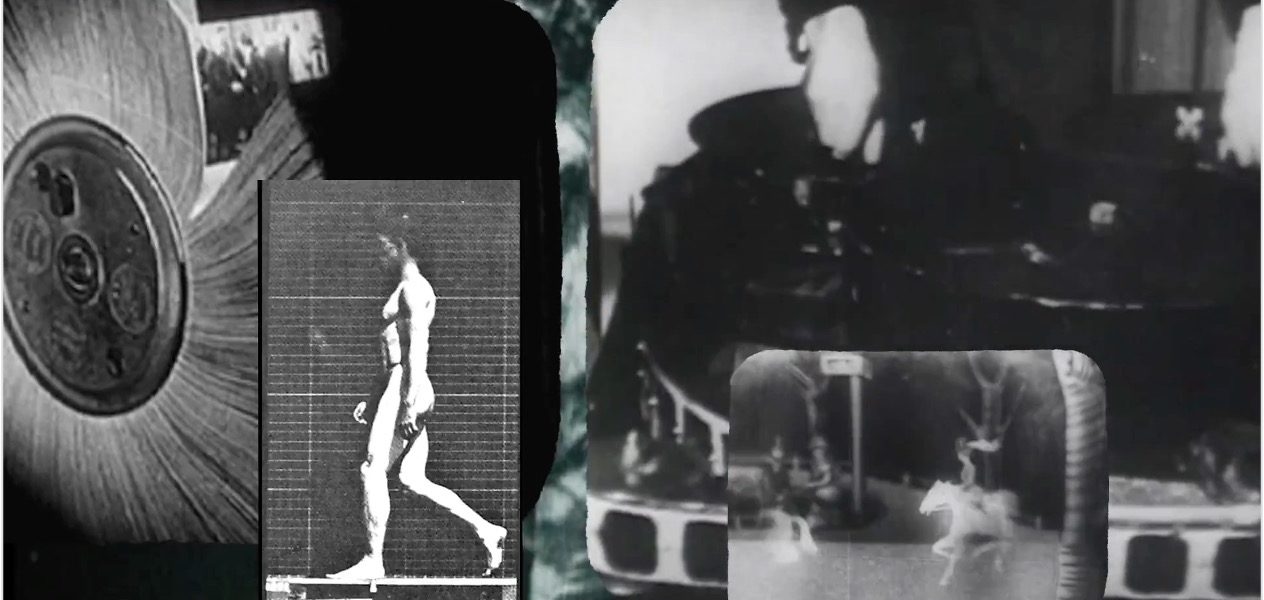The Movies Begin!
ZekeFilm is 10 years old in 2022! We’re commemorating it with a year-long Film Admissions series wherein each month, we take on a decade (give or take) of cinema, in chronological order. As is always the case with Film Admissions, participants are encouraged to watch a film within that month’s topic that they’ve never seen but have been meaning to. The bigger and more well known the film, the better! Then, together, we share our individual thoughts on our findings.

January finds us at the very beginning- of this year, and this exercise- but also at the nebulously pioneering dawn of cinema itself: 1895-1910!

“Sure it’s a miracle apparatus… but what do we do with it?” Such was the widespread sentiment regarding the newfangled motion picture camera. Variations on the technology had been kicking around at least since the latter quarter of the nineteenth century. But cinema wasn’t cinema until the Lumière brothers, Auguste and Louis, demonstrated an accompanying invention, their version of the motion picture film projector, for a public audience of the curious in the subterranean
Le Salon Indien du Grand Café located in Paris, France. It wasn’t the first time that a paying crowd gathered to collectively view projected flickering images of life- captured in actual movement!– on film, but it was the one that’s best remembered. That was December 28, 1895- the date that many choose to pinpoint as the day cinema was born.
Truth be told, 1895 and the years leading up to it were something of a whirlwind mishmash of would-be motion picture creators and rudimentary film exhibitors. (Does Émile Reynaud’s popular illustrated Pantomimes Lumineuses for his Parisian Théâtre Optique supersede everything else, qualifying as the truth birth of cinema? Or were his projected praxinoscope presentations simply an elaborate variation on popular parlor amusements of the day? The jury remains forever out on this.)
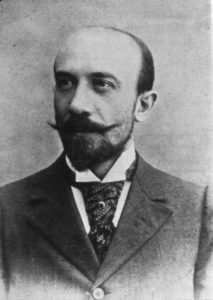
Nevertheless, circa 1895, untethered cinema-making curiosity was at a fever pitch. As this game-changing wonder of wonders caught on, various enterprising explorers of the new technology began pushing it in multiple directions. Some, such as magician George’s Méliès (well represented in this Film Admissions installment), seized upon its creative possibilities. Others, such as Charles Pathé, pursued cinema’s business potential. Yet others saw little potential in it whatsoever- such as the Lumières, ironically enough. Nonetheless, we needed them all to begin this ongoing precipitous journey of light and shadow.
The first films were rudimentary at best. This era’s “The Cinema of Attractions”, as it’s now sometimes referred, proved to be as freewheeling and diverse as vaudeville itself could be. The Lumiere’s glorified exposure tests of workers leaving work at their factory, and that supposedly very frightening train pulling into the station (L’arrivée d’un train en gare de La Ciotat) were initially the stuff of scientific novelty. Soon enough, though, staged scenarios would come to dominate the emerging medium. Commonly, every film, each running several minutes in length (if that) was shot very wide (i.e., stagey) and locked down, replicating the centric vantage point of a seated patron of the live theatre. Such familiar framing helped ease the otherwise shock of the new, as silent and monochrome as it was.
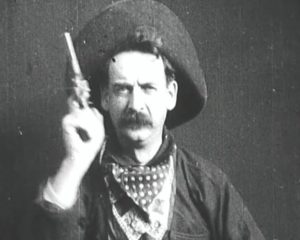
Then, Edwin Porter threw in a surprise close-up at the end of The Great Train Robbery– of a gunshot being fired into the camera, no less- and things really began to happen. Trial-and-error notions of visual grammar began to coalesce. Films of this time began yielding nothing less than the foundation of a whole new (albeit wordless) language, a means of expression and communication unfathomed in the course of human history. And if it was done to tastes, people would pay good money to see ‘em.
With over 126 years of hindsight, did they get it right? Has the miracle apparatus enabled a greater good? Some (in my own classrooms) have observed that the looping gifs and TikToks of today are essentially a reversion to the olden days’ “Cinema of Attractions”. Even so, in these first fifteen years of cinema, we see many roads being taken in the exploration of the machine of our dreams…
– Jim Tudor
Le Manior du Diable (The House of the Devil)
Directed by Georges Méliès/1896
by Sharon Autenrieth
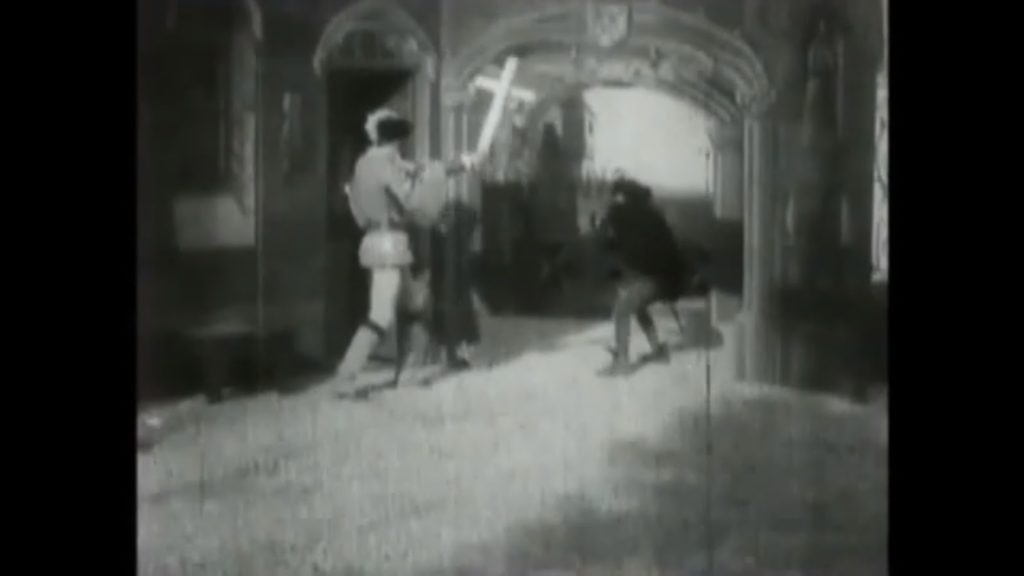
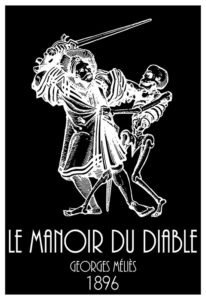
Le Manoir du Diable has it all: bats, a skeleton, witches, ghosts, moving furniture, a woman conjured out of a giant pot, and Satan himself, Old Scratch, Mephistopheles. And Georges Méliès packs this all into a movie that is just over three minutes long!
Méliès began his entertainment career as a stage illusionist, and while his first two films were documentary shorts, he became a live as a director when he discovered that film offered the opportunity for new avenues of illusion. Le Manior du Diable was only Méliès’ fifth film in his prolific career, but it has the notable distinction of being considered the first horror film. To be clear, Le Manior du Diable is not a scary film, nor was it intended to be. It’s comedy, but we might now classify it as a horror-comedy simply because it contains so many elements of classic horror. The movie is shot on one set with a fixed camera. A bat flies into the scene, then is transformed into Mephistopheles.
Mephistopheles conjures a cringing servant and a giant pot out of which he conjures a beautiful woman. Two young men enter the scene and while Mephistopheles hides, the servant jabs as the men with his pitchfork but disappears every time they look behind them. Eventually one of the men is frightened away, but the other sticks around to be startled by skeleton (which he tries to attack with his sword), frightened by ghosts, tormented by witches, and smitten by the young women – only to see her turn into an old hag before his eyes. In the end, the young man drives Mephistopheles away with a large crucifix. The trick shots are created through jump cuts, substitutions, and double exposures. They may look crude to modern eyes but they were fin de sièclestate of the art special effects and gave us enough elements to craft dozens, if not hundreds, of horror movies in the 20th century.
The Astronomer’s Dream
Directed by Georges Méliès/French/1898
by Jeffrey Knight
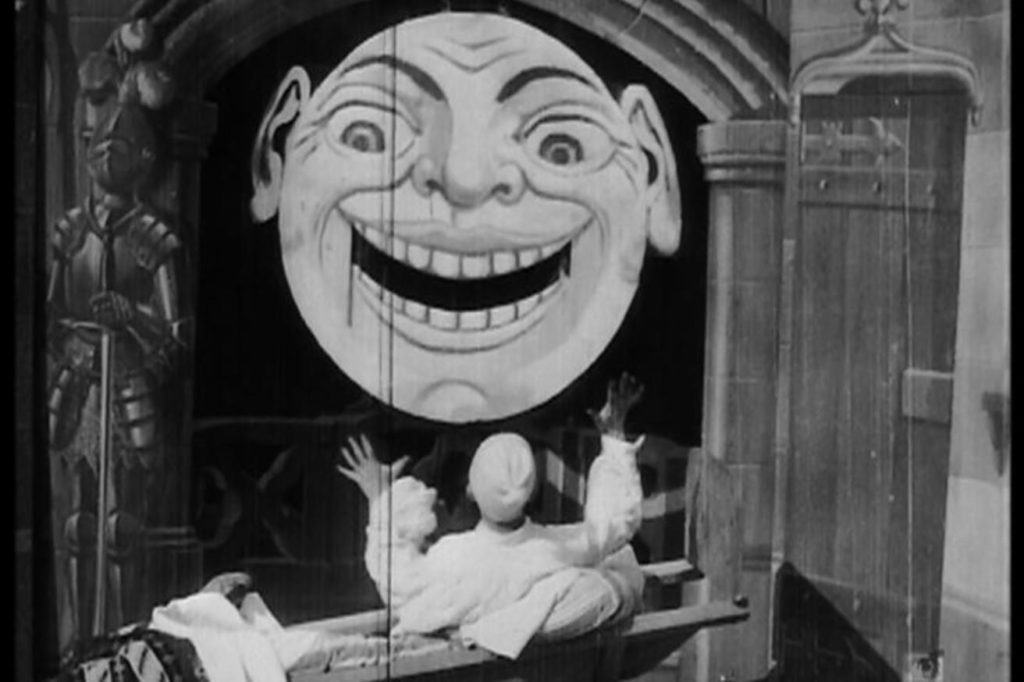
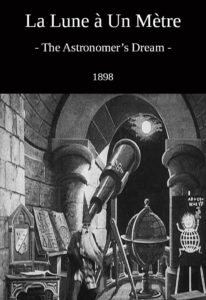
In December, 1895, Georges Méliès, a French illusionist and actor, attended a demonstration of the Lumiere brothers’ marvelous new invention, the cinematograph. By May, 1896, he was making his own movies. Over the course of the next couple of years, he produced over one hundred and fifty short films, most of which featured fantastic scenarios, elaborate sets, and special effects.
The Astronomer’s Dream was made in 1898. It was the third movie Méliès made that had a runtime of over 3 minutes (bloated runtimes isn’t just a modern scourge). Based on a stage show of his design, the movie stars Méliès as a wizard-like astronomer, who dozes off while observing the moon. The devil appears, then a woman. The woman sends the devil away, and the astronomer starts to dream. Objects appear and disappear. The astronomer falls down a lot as his chairs vanish from beneath him. The moon suddenly appears in his room and eats his telescope. Small creatures are disgorged from the moon’s mouth. Describing the events in the movie, one sounds like a 4-year-old trying to tell a joke. It’s stream-of-consciousness, and none of it makes any sort of sense. But it’s awfully entertaining all the same. The sets and costumes are intricately designed, the giant moon puppet is a sight to behold. Méliès was thrilled by the possibilities of this new art form, and his films showed that movies could make the impossible commonplace.
A Trip to the Moon
Directed by Georges Méliès/French/1902
by Taylor Blake
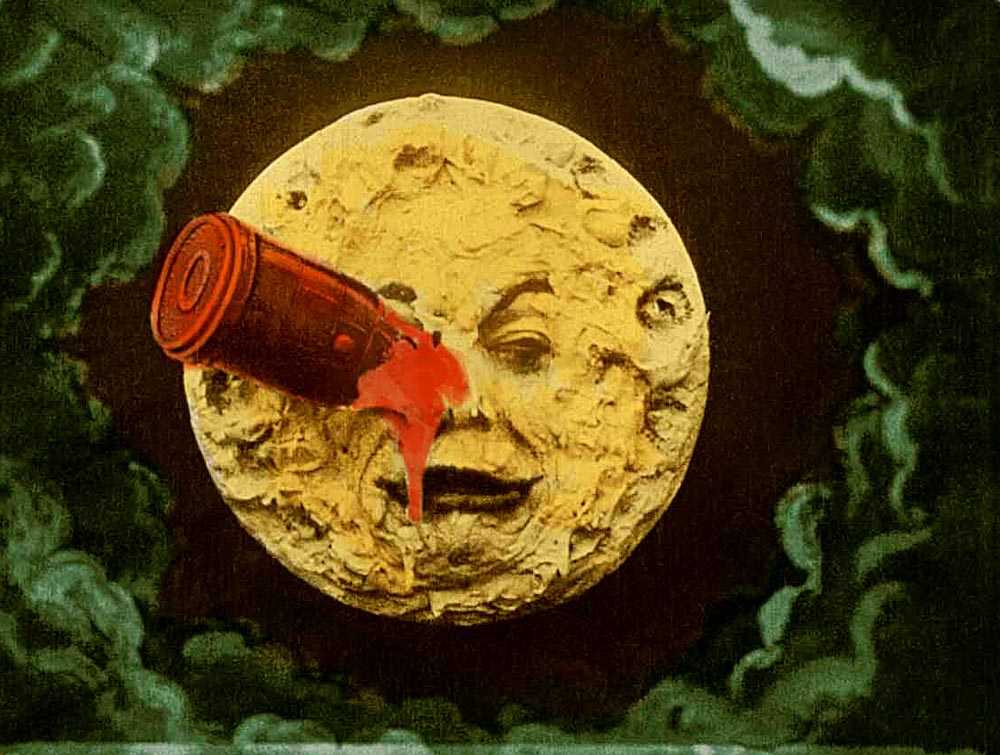
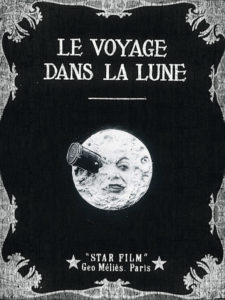
One of the reasons I love film is because it’s like seeing a vision into the past. In Harry Potter, the characters relive others’ memories in the Pensieve; the closest we have to that king of magic is watching a movie. Watching the earliest days of film feels like time traveling; the most basic storytelling motifs have not been established, and cameras are so basic it’s a miracle to see anything at all.
The Georges Méliès short A Trip to the Moon is like seeing the art form discovered in the moment. Because it’s a fantasy story and because it has required so much restoration, the changing frame rates and color tones make it feel like a fever dream of the past. In the Méliès vision, the Moon is another planet full of jungles and unusual creatures. While I was worried about how the travelers would return home without a rocket built into their ship, Méliès had another solution: They can just fall back to Earth. If we discovered a planet tomorrow, we’d know more about it in a month than people knew in 1902 about the Moon from the whole of history, but that did not stop Méliès and his team from innovating some of the first special effects and dreaming of the future of both exploration and filmmaking.
The Gay Shoe Clerk
Directed/photographed by Edwin S. Porter/1903
by Jim Tudor

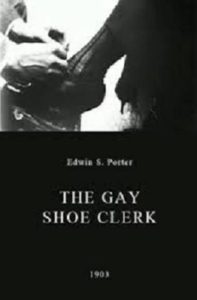
By today’s parlance, the title character of this in-studio seventy-second comedy vignette would appear more “shoe clerk” than “gay”. Back then, of course, a gay fella was just a spirited guy looking for a swell time. This character, portrayed by Edward Boulden, certainly seems to fit that bill. Then again, the argument could be had that the devil made him do it. That is, if one made the claim that the devil is a woman…
The setting is, unsurprisingly, a shoe store. (Or at least the wall of one). The standard very wide shot begins as two ornately garbed customers, ostensibly a mother and a grown daughter, are shown in and seated by the clerk. The younger one is immediately fitted. Clearly this is all quite the thrill for her, as, at the forty-seven second mark (Act II, if you will), she opts to teasingly distract the busy gentleman by incrementally hiking up her dress, all the way to nearly her knee. Porter, opportunizing the new medium in a salacious way, goes in for a gag-showcasing close-up. (This conventional cutting-on-action close-up is carried out by Porter the same year he ended The Great Train Robbery with a non-narrative shock-cut of a varmint firing into the camera). This ankle-obsessed moment of old-time voyeurism is accompanied with the sight of the clerk’s shoelacing hands going nervously faster and faster until, boom! The reveal of the woman’s thickly-stockinged leg is too much for him- he lunges forward for a smooch.
This being a primitive film comedy, it simply must end with a clobbering. Beaten repeatedly by the other woman’s umbrella, our gay shoe clerk flees the frame, definitely cancelled if not exactly cultured. No sale today! The joke, however, is actually on the audience: the record shows that the exhibitionist customer was played by a male employee at the Edison studio, where this was filmed. So maybe the title is more contemporary than we first thought…? Comedy was indeed finding its footing! Hey, if the shoe fits…!
Art’s Infancy
Directed by Émile Cohl/French/1910
by Ethan Halker
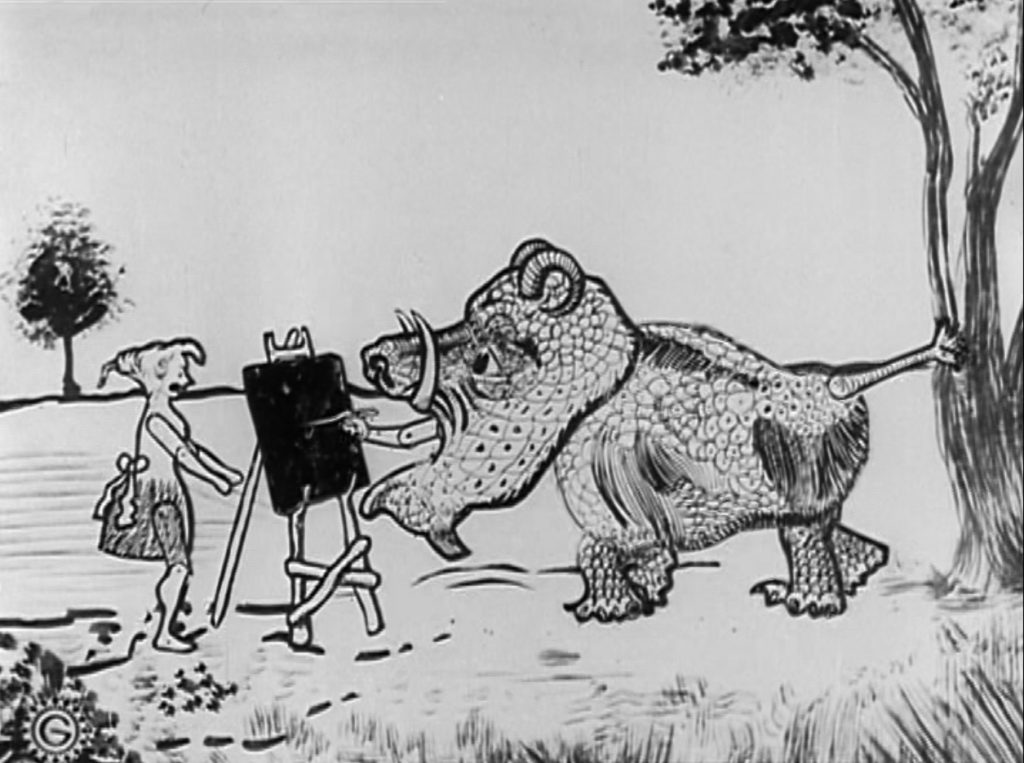
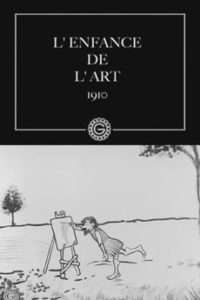
To enthusiasts of animation, the great Émile Cohl needs no introduction. Popularly considered the father of animation, Cohl was an inspiration for the first generation of animators, pioneering a number of the techniques that would make the labor intensive medium viable, all while infusing his films with a mix of absurdist dreaminess and dry humor. Art’s Infancy, a short directed by Cohl in 1910, is a wonderful example of his work.
The film opens on a sleeping caveman in close-up, represented by a paper doll figure with hinged joints, as he yawns and wakes. Following this, we see a primitive couple by a lakeside, similarly rendered as paper dolls. The woman walks off screen, while the man carries with him an easel, placing it on the ground and beginning a painting. Some monstrous creature walks into frame, trying and failing to attract a response from the painter before finally just eating him, as he continues to paint with his hand jutting out of the beast’s maw. The woman, returning to the scene, is sent into a panic, rushing around the beast and trying to get it to release the man, before finally managing to get him to leave the monster’s mouth by carrying his easel away, forcing the man to leave. The pair embrace, only for the man to continue painting.
The rest of the film is largely in the abstract, featuring pixilation animation of faces painted onto a hand, which then leaves a handprint on the center of the screen. This proceeds to morph into a variety of shapes, various creatures and abstract forms, before the film ends.
While its narrative portion is only two minutes long, in it one gets a sense of Cohl’s grasp on the medium. Various subtleties, like the beast dejectedly lowering its head, the painter flicking their wrist and examining the canvas as they consider their next stroke, and the incredulity of both the beast and wife at the painter’s continued work even after his rescue represent a sort of primitive character acting. The pixilation in the succeeding segment doesn’t grip as much, if only because of how relatively limited it is, but the sequences of morphing are effective. While the transformations are rendered with individual drawings for each two frames, the final forms of each metamorphosis take the shape of the articulated paper doll figures. While less charming than something like the subtly shifting volume of McCay’s Gertie, or even Cohl’s own Puppet character featured in Fantasmagorie, it’s a clever technique that allows him to easily maintain volume and delineate the transformations from the animation of the more solidly formed figures.
The score featured certainly complements the surreal strangeness of Cohl’s visuals. The version of the film included in Kino-Lorber’s Gaumont Treasures Volume 2 features a minimalist score by Bernard Lubat, using simplistic synthetic music, the sound of writing with chalk, bells, and generally accents the sense of mildly alienating playfulness that pervades Cohl’s work.
This is not to say that Art’s Infancy is Cohl’s best work. It’s crude and nonsensical, and isn’t quite so charming as his earlier, fully animated shorts. But it remains an enjoyable antique, employing a great deal of variety and offering a great deal to both those who wish to dissect its trickfilm visuals and those who wish to be caught up in the hypnotic, distinctive spell Cohl always manages to cast on his viewers.
Frankenstein
Directed by J. Searle Dawley/1910
by Robert Hornak

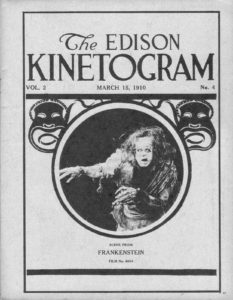
Watching this, in this form, choppy and frayed and looking like it’s been dipped in root beer and dragged across the floor of a Dairy Queen kitchen, gives the impression of found footage of an actual story – let’s say maybe the real-life home movies that inspired the story before the story was fiction. At thirteen and a half minutes it’s at best a highlight reel of everything we know – like the hell-fire-singed animatic for some longer, long-lost iteration that never was. Within 38 seconds, Frankenstein’s gone to college and already discovered “the secret of life”.
Cut to a shot of what looks like the good doctor forging a delicate roux in a pot, and then quickly we go to the money shot: in a secret closet, on a wide, stone pedestal, a mound of burning bone and flesh rise up into the shape of a demonic man, bone-arm rising in sudden self-aware horror – soon hair and features appear… Clearly this is something burned to a crisp, with the footage run backward, but the silent film ambiance – shaky, disturbed, unearthed – gives it a haunted edge that puts flesh-and-blood credence to Frankenstein’s transgression. When the demon-man’s hand edges around the door of the closet, the found-footage quality lends the moment a genuine chill.
Then, when we see the fullness of the creature, and it looks like, say, an entire ‘80s hair band melded and matted onto John the Baptist, some of the thrill is diminished. The creature, given life via chemical doings rather than by piecing together stolen body parts, feels almost Production Code-y, though long before that rule pressing was in play, so perhaps a narrative short-cut for budgetary purposes? Hard to know, but not a deal- breaker, as the entire Edison Company-produced movie (the first filmed version of the tale) comes off as earnest, creepy, revolting, and whole on its own terms. When Frankenstein, in the final sequence, sees the creature in his own reflection, then seems to banish the fiend into Bewitched-style non-existence with a single furious wave of his finger, it’s not the book, or any movie iteration that we’ve seen, but its own fast-motion treatise on redemption in rudimentary horror garb. Not exactly Karloff, but it’s still alive.


